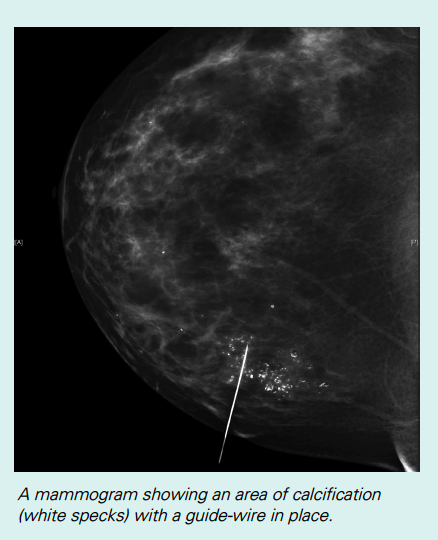[This information guide is also available inPDF format to download.]
What is hookwire localisation?
Hookwire localisation is a pre-surgical procedure used to mark the exact location of an abnormal area in the breast that was detected through imaging such as a mammogram or ultrasound. This helps the surgeon to accurately locate and remove the breast tissue during lumpectomy or excisional biopsy.
Why is hookwire localisation needed?
- Precision in surgery: The procedure ensures that the surgeon removes the correct area of tissue.
- Minimally Invasive: Helps in targeting small or nonpalpable abnormalities without unnecessary removal of healthy breast tissue.
- Diagnostic Accuracy: Increases the accuracy of diagnosing breast abnormalities and reduces the need for additional surgeries.
When is hookwire localised breast surgery recommended?
- Confirmed Cancer: This approach is often taken to remove the cancerous tissue while maintaining as much of the healthy breast tissue as possible. The hookwire helps the surgeon precisely locate and remove only the affected area.
- Inconclusive Biopsy: In cases where initial biopsy results are inconclusive, or the abnormality is too small or difficult to target with needle biopsy, hookwire localisation can help accurately locate the area for durgical removal and further testing. Additional Tissue Needed: Sometimes, initial biopsy techniques do not provide enough tissue to make a definitive diagnosis. Hookwire localisation allows for a larger and more precise tissue sample to be obtained for thorough pathological examination.
How to prepare for hookwire localisation
- Scheduling: The procedure is typically done on the same day as surgery. The surgical team will arrange the hookwire localisation appointment, and reception staff will inform you of the date and time.
- Medication: Inform your surgeon about any medications you are taking. You may be asked to stop taking blood thinners before the procedure.
- Fasting: Follow any fasting instructions provided by your healthcare/surgical team.
What to expect during the procedure
- Imaging Guidance: You will be positioned for either a mammogram or ultrasound to locate the abnormal area by the radiographer/sonographer.
- Anesthesia: The radiologist will administer local anesthesia to numb the area.
- Hookwire Insertion: After the local anaesthetic takes effect, a fine needle with a hooked wire will be inserted into the breast tissue to mark the abnormality. Afterwards, the needle is withdrawn, leaving the hookwire in place within the abnormal area. The external portion of the wire is then secured with tape.
- Hookwire Placement Confirmation: The position of the wire will be verified with additional imaging to ensure accurate placement.
- Preparation for Surgery: The hookwire will remain in place until your surgery to guide the surgeon.
What happens after localisation
- Escort to Day Care Surgery Unit: After the hookwire procedure, a nurse will accompany you to the Day Care Surgery Unit.
- Transition to Day Care Surgery Staff: The staff in the Day Care Surgery Unit will take over your care and begin preparing you for your scheduled surgery
- Preparation for Surgery: In the Day Care Surgery Unit, you will undergo a series of preparatory steps, including changing into a surgical gown and receiving any necessary pre-operative instructions.
- Surgical Review: Your surgeon may review the details of your procedure and confirm the next steps with you.
- Pre-surgery Monitoring: You will be monitored for any immediate reactions or complications from the hookwire procedure before proceeding to surgery.
- Surgery Commencement: Once prepared, you will be taken to the operating room for your scheduled surgical procedure.
Risks and complications of hookwire procedure
- Bleeding: Minor bleeding at the insertion site
- Infection: Although the risk of infection is negligible, all necessary precautions are taken to minimise any risk of infection, especially since the hookwire procedure is performed before surgery.
- Displacement: Rarely, the wire may move, requiring repositioning.
Benefits of hookwire localisation
- Targeted Surgery: Increases the accuracy of surgical procedures.
- Better Outcomes: Reduces the likelihood of additional surgeries.
- Efficient Diagnosis: Facilitates the precise removal of abnormal tissue for diagnosis.
Wound care
After the operation the wound may be covered with steri strips (paper tapes) and a dressing. In most cases you will be asked to leave the dressing in place until your appointment with the surgeon. Usually stitches do not need to be removed because dissolving stitches are used.
Your surgeon or nurse will give you instructions about what to do before you leave hospital. Before you leave the hospital, a follow-up appointment will be arranged for you. This visit is usually 7–10 days after the operation.

Any questions?
If you would like more information about hookwire localised procedures or the operation, please ask your surgeon, breast care nurse or another member of your treatment team.
Useful contacts/websites
| Cancer Australia | canceraustralia.gov.au |
| Cancer Council | cancer.org.au |
| Cancer Council Helpline | 13 11 20 |
| Breast Cancer Network Australia (BCNA) | 1800 500 258 bcna.org.au |
Version 7 – WSP 233 March 2025
© Westmead Breast Cancer Institute 2025
[This information guide is also available in PDF format to download.]
